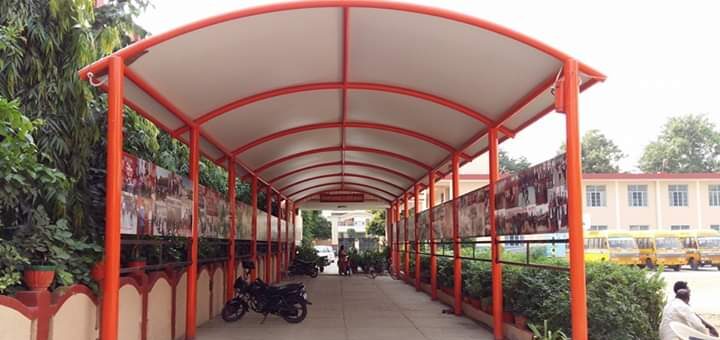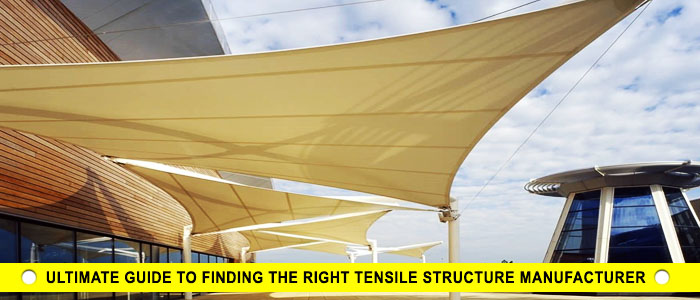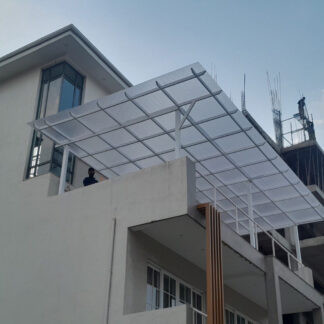What is a Tensile Entrance Structure?
December 14, 2025 By admin

What is a Tensile Entrance Structure?
Have you ever been to a hotel, stadium, or shopping mall and marvelled at the sight of a beautiful and wavy canopy that appears to hang freely high above the entry? It is, however, certainly a tensile entrance structure, a true masterpiece of modern engineering and design. The question is what it is and why it is gaining popularity among architects and developers the world over. This novice manual will simplify it for you.
Basic Tensile Structure: What is it?
A tensile structure is a type of building in its most basic form, which derives its stability through tension. Tensile structures are contrasted with traditional buildings that depend on compression (bricks on top of each other). Tensile structures are built out of specially engineered fabric membranes that are extended and drawn taut between a network of cables, masts, and other structural elements.
Think of a canvas stretched over a frame of wood, but in a huge, architectural size, with immensely strong and highly technological materials. This rule enables the design of vast, columnless spaces with theatrical, architectural lines.
The Headliner: The Tensile Entrance Structure
One of the uses of this technology is a tensile entrance structure, which is a structure designed to create an attractive and inviting entrance to a building. It is much more than a roof, and it is a statement. It will inform visitors, even before they enter through the door, that they have arrived somewhere special.
These buildings are intended to be aesthetically lightweight, and they may be transparent so that the daylight penetrates through them to light up the building beautifully in the evening, which also illustrates itself as a glamorous contour at night.
How Does It Work? The Magic of Tension
It is not a magic effect; it is physics as well. The major parts can be broken down in the following way:
- The Membrane: This refers to the fabric skin, which is normally composed of such materials as PVC-coated polyester, PTFE-coated fiberglass, or ETFE foil. Not only are these highly durable and weather-resistant, but they can also be designed in such a way as to be self-cleaning or possess unique light transmission qualities.
- The Support System: This is a collection of high-strength steel cables that spread the tension of the membrane.
- The Anchors and Masts: These are the concrete parts, such as poles, arches, or walls, that hold the whole system down and all of it up. The cables draw the membrane into these fixed points.
The combination of all these parts gives the structure a remarkably high strength and stability, and makes it able to stand against the wind, rain, and snow.
Beyond the Entrance: Other Common Applications
The versatility of tensile technology means it’s used in many other ways. You’ve probably seen:
- Tensile Walkway Structure: Providing sheltered pathways between buildings, like on a university campus or hospital complex. They guide foot traffic while protecting people from the elements.
- Tensile Car Parking: Also known as tensile shade sails or carports, these provide shade and protection for vehicles, reducing interior car heat and protecting against hail and UV damage. They are a popular and cost-effective alternative to concrete structures.
Why Choose a Tensile Structure? The Key Benefits
So, why would a business or city choose a tensile structure over traditional materials?
- Stunning Aesthetics: The unique, fluid forms create an iconic and modern look that is hard to achieve with any other method.
- Cost-Effective: For covering large spans, tensile structures can be more economical than steel and glass, requiring less material and often a faster installation time.
- Durability & Low Maintenance: The fabrics are engineered to last for decades and are resistant to rot, mildew, and UV radiation. Many require only occasional cleaning.
- Natural Light & Energy Efficiency: The translucency of the fabric reduces the need for artificial lighting during the day, cutting down on energy costs.
- Design Flexibility: From soaring peaks to gentle curves, the design possibilities are almost endless, allowing for complete customization to fit a brand’s identity.
The Global Tensile Movement
The adoption of tensile architecture is truly a global tensile phenomenon. From the iconic Hajj Terminal in Saudi Arabia to the Denver International Airport in the USA and spectacular sports arenas across Europe and Asia, these structures are defining the skylines of the 21st century. They represent a global shift towards lightweight, sustainable, and human-centric architecture.
In Conclusion
A tensile entrance structure is more than just a functional cover. It is a powerful blend of art and science that creates a memorable first impression. Whether used as an entrance, a tensile walkway structure, or for tensile car parking, this technology offers a smart, beautiful, and practical solution for modern construction needs.






